


Looking for an egg-free alternative to traditional mayonnaise? Look no further! This vegan version is just as creamy and flavorful as the classic version. It’s great for making sandwiches, adding to dressings, and throwing into salads.
Instead of regular mayonnaise, vegan mayonnaise is a great option without any eggs. It can be used to make sandwiches, dressings, and salads. The two main ways to prepare vegan mayonnaise using either a food processor or an immersion blender. Consider adding ingredients such as garlic (garlic aioli) and maple syrup, or sriracha for spicy mayo. Moreover, using fresh or dried herbs like parsley or dill will further enhance the flavor.
Why Choose Vegan Mayonnaise?
- Healthier Alternative: Vegan mayo typically contains fewer calories and fats compared to conventional mayonnaise. Plus, it avoids cholesterol, making it heart-friendly.
- Dietary Flexibility: It caters to vegans, vegetarians, and those allergic to eggs or dairy.
- Customizable: Homemade vegan mayonnaise lets you control the flavor, texture, and ingredients, ensuring no hidden additives or preservatives.
Vegan Mayonnaise Ingredients
- 1/2 cup unsweetened plant-based milk: Soy milk works best because it emulsifies well, but almond or cashew milk can also be used. Soy milk is recommended for this recipe, or aquafaba (the liquid from a can of cooked chickpeas).
- 1 cup neutral-flavored oil: Sunflower, grapeseed, or avocado oil are excellent choices. Avoid olive oil for this recipe as its flavor can be overpowering.
- 1 tablespoon apple cider vinegar or lemon juice: Provides the tanginess that mimics traditional mayonnaise.
- 1 teaspoon Dijon mustard: Enhances the flavor with a slight tangy kick.
- 1/2 teaspoon salt: Adjust according to your taste.
- ¼ teaspoon garlic powder (optional)
- Optional sweetener: Add 1/2 teaspoon of maple syrup or agave nectar for a touch of sweetness.
How to Make Vegan Mayonnaise Using an Immersion Blender

An immersion blender (also known as a hand blender) is one of the easiest and most foolproof ways to make vegan mayonnaise. It ensures perfect emulsification, creating a creamy, thick, and delicious mayo in just minutes. Follow these simple steps to achieve the best results.
Step 1: Choose the Right Container
For the best results, use a tall, narrow jar (like a mason jar) that fits the head of your immersion blender snugly. This helps create the proper emulsification.
Step 2: Add the Ingredients
Pour all the ingredients into the jar in this order:
- Plant-based milk
- Apple cider vinegar
- Dijon mustard
- Salt
- Oil (pour it on top)
Do not stir or mix before blending. Keeping the ingredients layered is key to emulsification.
Step 3: Blend Without Moving
Insert the immersion blender all the way to the bottom of the jar. Start blending on high speed without moving the blender for about 10–15 seconds. You will see the mixture begin to thicken at the bottom.
Step 4: Slowly Lift the Blender
Once the bottom part is emulsified, slowly lift the blender while still running to incorporate the remaining oil. This process should take another 10–15 seconds until the mayo is fully blended and thick.
Step 5: Adjust and Store
- Taste your mayo and adjust seasoning if needed (add more salt, vinegar, or a touch of sweetener).
- If it’s too thick, mix in a teaspoon of plant-based milk at a time until desired consistency is reached.
- Transfer the mayo to an airtight container and refrigerate for at least 30 minutes before using. It will thicken as it chills.
How to Make Vegan Mayonnaise Using a Food Processor


Making vegan mayonnaise in a food processor is just as easy as using a blender. The key is to add the oil gradually to ensure proper emulsification, resulting in a thick and creamy texture. Follow these step-by-step instructions to achieve perfect homemade vegan mayo.
Step 1: Prepare the Food Processor
- Attach the S-blade or emulsifying blade to your food processor.
- Make sure the bowl is completely dry and clean to avoid separation issues.
Step 2: Add the Base Ingredients
- Pour soy milk, apple cider vinegar, Dijon mustard, and salt into the food processor.
- Blend on low speed for about 10–15 seconds until everything is well combined.
Step 3: Slowly Add the Oil
- While the processor is running, very slowly drizzle in the oil through the feed tube.
- This gradual process is crucial for emulsification, creating a thick and creamy texture.
- Continue blending for 1–2 minutes, or until the mayo thickens.
Step 4: Check the Consistency
- Stop the food processor and scrape down the sides if needed.
- If the mayo is too thin, blend for another 30 seconds or add a bit more oil.
- If it’s too thick, add 1 teaspoon of plant-based milk at a time and blend again.
Step 5: Taste and Adjust
- Taste your mayo and adjust the seasoning.
- Add more salt, vinegar, or mustard if needed.
Step 6: Store and Chill
- Transfer the mayonnaise to an airtight container or jar.
- Refrigerate for at least 30 minutes before using. This helps the flavors meld and the mayo thicken.
Nutritional Information for Vegan Mayonnaise (Per 1 tablespoon serving – makes approximately 10–12 servings): Calories: 90-Total Fat: 10g-Saturated Fat: 1g-Cholesterol: 0mg-Sodium: 50mg-Carbohydrates: 0.5g-Fiber: 0g-Sugars: 0g (may vary if adding a sweetener)-Protein: 0.2g
Key Nutritional Highlights:
- Low in Cholesterol: Since this recipe is egg-free, it contains no cholesterol, making it a heart-healthy option.
- Healthy Fats: The primary source of fat comes from plant-based oils like avocado, sunflower, or light olive oil, which are rich in monounsaturated and polyunsaturated fats. These fats are beneficial for heart health and can help reduce bad cholesterol levels.
- Low in Carbs: Vegan mayonnaise is naturally low in carbohydrates, making it suitable for low-carb or keto diets.
- No Added Sugar: Unless you include maple syrup or agave, this recipe contains minimal natural sugars.
- Allergen-Friendly: Free from eggs, dairy, and gluten (if using gluten-free plant-based milk), this mayo is ideal for those with dietary restrictions.
How to Make It Healthier:
If you’re looking to reduce calories or fat, consider these tweaks:
- Use Less Oil: Reduce the amount of oil to 1 cup (as we are using) instead of 1 ½ cups. This will lower the fat content but may result in a slightly thinner consistency.
- Choose a Lighter Oil: Opt for oils lower in calories, such as light olive oil or grapeseed oil.
- Add Aquafaba: Replace a portion of the oil with aquafaba (chickpea brine) for a lighter, oil-free version.
Video
Tips for Perfect Vegan Mayonnaise
Soy milk is recommended for this recipe. Aquafaba (the liquid from a can of cooked chickpeas) can be used.
Almond milk works too, but the consistency won’t be as thick.
Apple cider vinegar is ideal, however lemon juice can be used as a substitute. Other types of neutral flavor vinegar may also work, such as white wine or rice vinegar. Balsamic vinegar is not recommended.
Use a Neutral Oil: Avoid strongly flavored oils like extra virgin olive oil, as they can overpower the taste. Opt for light olive oil, sunflower oil, or avocado oil instead.
Add the Oil Slowly – Pouring too fast can cause separation, resulting in a runny mayo.
Room Temperature Ingredients: Ensure all your ingredients are at room temperature to help with emulsification.
Use Proper Equipment: An immersion blender in a narrow jar works wonders for consistent results.
Experiment with Flavors – Add garlic powder, smoked paprika, or fresh herbs for variety.
How to Use Vegan Mayonnaise
Vegan mayonnaise is incredibly versatile and can be used just like traditional mayonnaise. Here are some ideas:
- Sandwiches and Wraps: Spread it on bread for a creamy, tangy base.
- Salads: Use it as a dressing for coleslaw, Caesar or potato salad.
- Dipping Sauce: Use as a base for sauces like tartar sauce or remoulade. Mix it with ketchup, hot sauce, or sriracha for a quick dip.
- Burgers: Top your plant-based burgers with a dollop of vegan mayo.
- Cooking: Incorporate it into recipes like vegan aioli, creamy pasta dishes, or dips.
Storing Vegan Mayonnaise
Homemade vegan mayonnaise can be stored in the refrigerator for up to one week. Ensure the jar is sealed tightly to maintain freshness. Avoid freezing as the texture may become grainy when thawed.
Frequently Asked Questions
1. Can I use a different plant-based milk?
Yes, you can use almond, oat, or cashew milk. However, soy milk works best due to its high protein content, which helps with emulsification.
2. Why did my mayo turn out runny?
This can happen if the oil is added too quickly or if the ingredients weren’t cold. To fix it, blend in an additional tablespoon of plant-based milk and slowly add more oil until it thickens.
3. Is vegan mayonnaise gluten-free?
Yes, as long as you use gluten-free plant-based milk and vinegar, this recipe is naturally gluten-free.
4. Can I make it oil-free?
While oil is essential for the creamy texture, you can experiment with aquafaba (chickpea brine) or silken tofu as a base for an oil-free version.
Related Recipe:
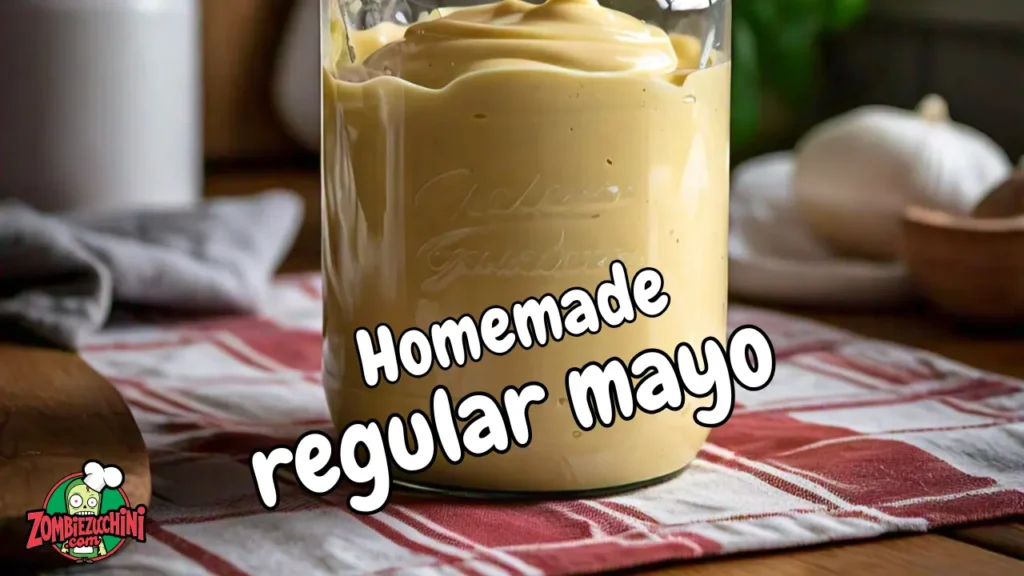


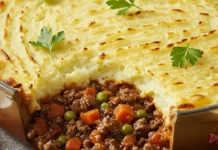





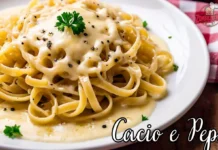
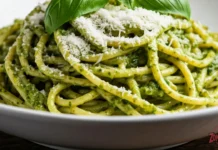






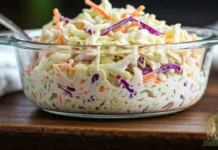
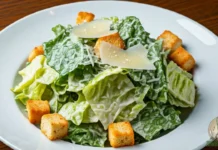
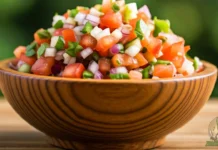
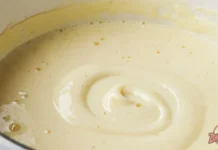
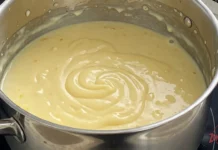

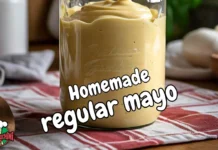
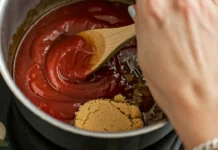
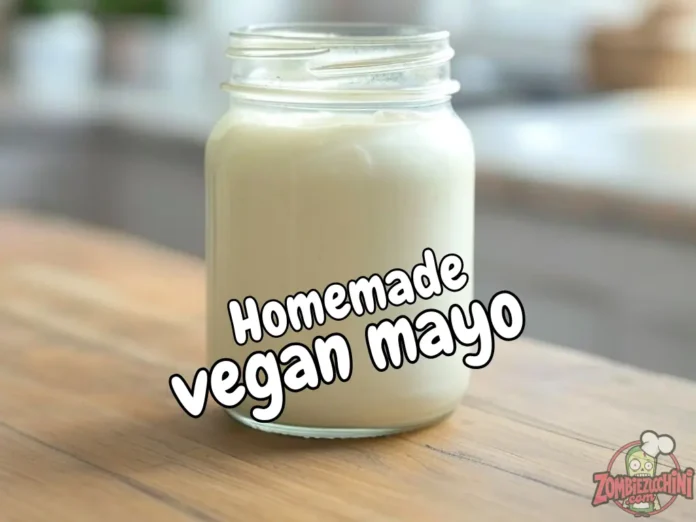

Pro tip, every time you open a can of chickpeas, you can save all that chickpea water into ice cube molds in the freezer for future use
SLOWLY like glacier pace slow! It is the difference between success and failure! My first attempt was… a disaster… as I “slowly” added the oil on a “slow” blender speed. I am still finding things I need to clean up from the attempt (three weeks ago). SLOW is the key!
you must only use an immersion mixer. I used to make garlic sauce and this is the only way it would come out like mayonnaise. I first tried with my blender, but it’s too powerful. I remixed the “soupy sauce” with the immersion mixer and it thickened.
My blender makes a very big mess it splashes everywhere is that normal?